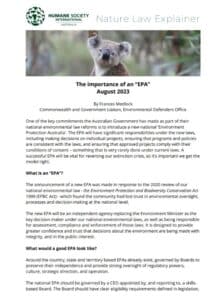One of the most important global meetings on wildlife trade has just wrapped up in Uzbekistan. It’s capital city Samarkand was where governments convened for the 20th Conference of the Parties (CoP20) to the Convention on International Trade in Endangered Species of Wild Fauna and Flora (CITES) to decide how international trade should be managed for some of the world’s most threatened...
Guest Blog – By Frances Medlock, Commonwealth and Government Liaison, Environmental Defenders Office
One of the key commitments the Australian Government has made as part of their national environmental law reforms is to introduce a new national ‘Environment Protection Australia’. The EPA will have significant responsibilities under the new laws, including making decisions on individual projects, ensuring that programs and policies are consistent with the laws, and ensuring that approved projects comply with their conditions of consent – something that is very rarely done under current laws. A successful EPA will be vital for reversing our extinction crisis, so it’s important we get the model right.
What is an “EPA”?
The announcement of a new EPA was made in response to the 2020 review of our national environmental law – the Environment Protection and Biodiversity Conservation Act 1999 (EPBC Act) – which found the community had lost trust in environmental oversight, processes and decision-making at the national level.
The new EPA will be an independent agency replacing the Environment Minister as the key decision maker under our national environmental laws, as well as being responsible for assessment, compliance and enforcement of those laws. It is designed to provide greater confidence and trust that decisions about the environment are being made with integrity, and in the public interest.
What would a good EPA look like?
Around the country, state and territory based EPAs already exist, governed by Boards to preserve their independence and provide strong oversight of regulatory powers, culture, strategic direction, and operation.
The national EPA should be governed by a CEO appointed by, and reporting to, a skills-based Board. The Board should have clear eligibility requirements defined in legislation, and include independent experts in environmental regulation and science, and First Nations representation. There must be strict rules to manage conflicts of interest. Unfortunately, the Government’s commitment to an EPA through its Nature Positive Plan doesn’t include a proposal to have an independent Board. This is something we are asking them to change.
Regardless of the model chosen, appointment of the CEO must be based on legislative criteria stipulating the necessary skills and experience for the role.. However, if the Minister is responsible for appointing the CEO, we need greater transparency in the appointment process in addition to the statutory skills criteria. This means appointment should take place through a public recruitment process, including initial assessment by an independent panel following public advertising of the role, and the Minister’s choice should be informed by this assessment.
It will be important that the new EPA is free from political influence. The Minister may be able to issue a Statement of Expectations, to provide clarity about relevant government policies and objectives, but the Minister shouldn’t be able to direct the EPA to make specific decisions or take certain actions. The EPA must be an independent decision maker.
The EPA must be adequately resourced and have secure, long-term funding to perform its duties and ensure community confidence in the application of our national environmental laws.
At the moment, the Australian Government is proposing that role of the EPA will be limited to matters currently under the EPBC Act. However, we think the EPA could be expanded to oversee other national environmental matters, like pollution laws. To support this, we want to see the EPA created by standalone legislation that can be easily expanded in the future.
For more information on what a good EPA looks like, see: Implementing effective independent Environmental Protection Agencies in Australia (EDO 2022).
What would the EPA be responsible for?
The EPA should be responsible for making all project approval decisions under our national environmental laws by first considering whether a project will have unacceptable impacts and should be refused, and then ensuring proposals are in line with National Environmental Standards. Not sure what National Environmental Standards are? Click here for HSI’s explainer.
It is also important the EPA has a clear role, outlined in the legislation, for developing and creating additional National Environmental Standards, which it will be responsible for implementing and enforcing.
In addition to project level decision making, the EPA should be responsible for ensuring that any plans, policies, and programs developed under new national environmental laws comply with National Environmental Standards.
The new EPA should also be responsible for compliance and enforcement activities, including monitoring project conditions after approval.
But there’s changes that need to be made, so that the EPA works properly
In addition to the need for an EPA to have an independent Board, we need to make sure that any exemptions to the decision making processes outlined above are strictly constrained. The Nature Positive Plan proposes that there will be a Ministerial ‘call-in power’, which takes decisions away from the EPA to be made by the Minister. Any ‘call-in power’ must be limited to a list of specific circumstances, be subject to public consultation and advice from the EPA (which must be published), and have a clear indication of when in the decision-making process the call-in can occur.
We also need to make sure that the community can better know and understand the decisions that are being made under our national environmental laws, especially if the Minister is using special powers to bypass the usual decision making process. New national environmental laws must have better and more effective transparency and accountability measures than the current laws, and they must include the ability for the community to legally challenge decisions, both if the Government makes legal errors or if the community disagrees on the merits of the decision.
We are expecting to see draft legislation establishing the new EPA later this year. This draft legislation will be available for public comment so at that point it will be important for the Government to hear from the community that they want a strong and independent EPA.
Download a PDF version of this blog, so you can print and share with your Member of Parliament
Learn more about what we need to achieve stronger laws for Australian nature. Read our previous Nature Explainer blogs:
- Critical Habitat Needs Protection
- Community Rights in Decision Making
- What are National Environmental Standards and why do we need them?
- Managing Wildlife Trade
- Objects and Duties
- Strengthening Conservation Planning
- Climate change
- Nature Laws Explainer: Protecting Marine and Migratory Species
- Regional Planning
- What are biodiversity offsets? (Part 1)
- What are biodiversity offsets (Part 2)
- What ‘triggers the EPBC act?
- Strong nature laws shouldn’t be undermined by exemptions
- Environmental assessments and decision-making



